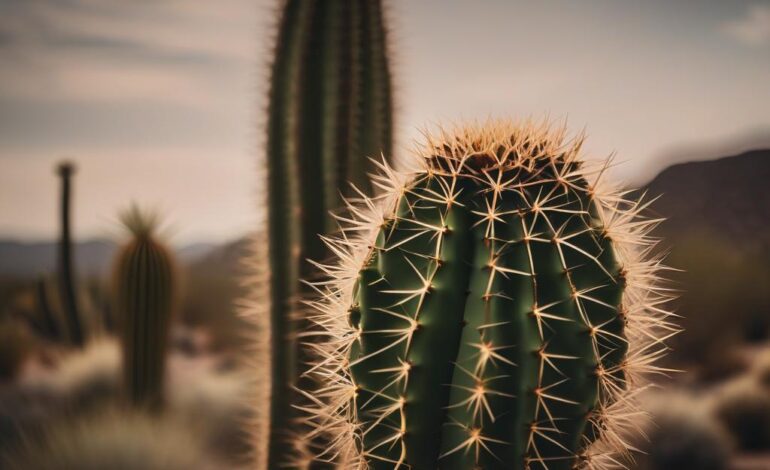How Are Cacti Adapted to Survive in a Desert?

-
Table of Contents
- How Are Cacti Adapted to Survive in a Desert?
- 1. Succulent Stems and Leaves
- 2. Spines for Protection
- 3. CAM Photosynthesis
- 4. Extensive Root Systems
- 5. Waxy Cuticle and Sunken Stomata
- Q&A
- Q1: How do cacti store water?
- Q2: How do cacti protect themselves from herbivores?
- Q3: How do cacti carry out photosynthesis in the desert?
- Q4: How do cacti absorb water from the desert soil?
- Q5: How do cacti minimize water loss through evaporation?
- Summary
Deserts are harsh and unforgiving environments, characterized by extreme temperatures, scarce water resources, and limited vegetation. Yet, amidst these challenging conditions, cacti thrive and have become iconic symbols of desert landscapes. These remarkable plants have evolved a range of adaptations that allow them to survive and even thrive in the arid desert environment. In this article, we will explore the fascinating ways in which cacti have adapted to their surroundings, from their unique physical features to their efficient water storage and conservation mechanisms.
1. Succulent Stems and Leaves
One of the most distinctive features of cacti is their succulent stems and leaves. Unlike most plants, cacti have reduced or absent leaves, which helps to minimize water loss through transpiration. Instead, their stems have evolved to store water, allowing them to survive for long periods without rainfall. The thick, fleshy stems of cacti are capable of expanding and contracting as they store and release water, enabling them to adapt to fluctuating water availability in the desert.
For example, the iconic Saguaro cactus (Carnegiea gigantea) found in the Sonoran Desert of North America can store up to 200 gallons (757 liters) of water in its stem during the rainy season. This stored water sustains the cactus during the long, dry periods when water is scarce.
2. Spines for Protection
Cacti are well-known for their spines, which serve multiple purposes, including protection from herbivores and reducing water loss. The spines of cacti are modified leaves or specialized structures called areoles. These spines help to deter animals from feeding on the cactus, as they can cause injury or discomfort. Additionally, the spines create a layer of still air around the cactus, reducing air movement and thus minimizing water loss through evaporation.
Some cacti, such as the Barrel cactus (Ferocactus spp.), have long, sharp spines that provide effective defense against large herbivores like deer. Other cacti, like the Prickly Pear cactus (Opuntia spp.), have smaller, hair-like spines called glochids, which easily detach and can cause irritation if they come into contact with the skin or eyes of animals.
3. CAM Photosynthesis
Cacti have also developed a unique form of photosynthesis called Crassulacean Acid Metabolism (CAM). Unlike most plants, which open their stomata during the day to take in carbon dioxide for photosynthesis, cacti keep their stomata closed during the day to reduce water loss. Instead, they open their stomata at night when temperatures are cooler and humidity is higher, allowing them to take in carbon dioxide and store it as malic acid in their cells.
During the day, when the stomata are closed, cacti use the stored malic acid to carry out photosynthesis. This adaptation allows cacti to conserve water by minimizing daytime transpiration while still being able to produce energy through photosynthesis.
4. Extensive Root Systems
Cacti have evolved extensive root systems that enable them to efficiently absorb water from the desert soil. The roots of cacti are shallow and spread out horizontally, allowing them to capture water from a larger area. Some cacti also have long taproots that can reach deep into the ground to access water sources that are beyond the reach of other plants.
For example, the Fishhook cactus (Mammillaria spp.) has a shallow root system that spreads out in all directions, maximizing its ability to capture water from the surface. On the other hand, the Saguaro cactus has a deep taproot that can reach depths of up to 5 feet (1.5 meters), enabling it to access groundwater reserves.
5. Waxy Cuticle and Sunken Stomata
To further reduce water loss through evaporation, cacti have developed a waxy cuticle on their stems and leaves. This cuticle acts as a waterproof barrier, preventing water from escaping through the surface of the plant. Additionally, the stomata of cacti are often sunken into pits or grooves on the surface of the stem, which helps to reduce air movement and water loss.
The combination of a waxy cuticle and sunken stomata allows cacti to minimize water loss while still being able to exchange gases for photosynthesis. This adaptation is crucial for their survival in the desert, where water is scarce and evaporation rates are high.
Q&A
Q1: How do cacti store water?
A1: Cacti store water in their thick, fleshy stems. These stems are capable of expanding and contracting as they store and release water, allowing cacti to survive for long periods without rainfall.
Q2: How do cacti protect themselves from herbivores?
A2: Cacti have spines that serve as a defense mechanism against herbivores. These spines can cause injury or discomfort, deterring animals from feeding on the cactus.
Q3: How do cacti carry out photosynthesis in the desert?
A3: Cacti use a unique form of photosynthesis called CAM (Crassulacean Acid Metabolism). They keep their stomata closed during the day to reduce water loss and open them at night to take in carbon dioxide, which is stored as malic acid and used for photosynthesis during the day.
Q4: How do cacti absorb water from the desert soil?
A4: Cacti have extensive root systems that efficiently absorb water from the desert soil. Their shallow roots spread out horizontally to capture water from a larger area, while some cacti also have long taproots that can reach deep into the ground to access water sources.
Q5: How do cacti minimize water loss through evaporation?
A5: Cacti have a waxy cuticle on their stems and leaves, which acts as a waterproof barrier, preventing water from escaping through the surface of the plant. Additionally, their stomata are often sunken into pits or grooves on the stem, reducing air movement and water loss.
Summary
Cacti have evolved a range of remarkable adaptations that allow them to survive and thrive in the harsh desert environment. Their succulent stems and reduced leaves enable them to store water, while their spines provide protection from herbivores and reduce water loss. The unique CAM photosynthesis allows cacti to conserve water while still being able to produce energy. Their extensive root systems efficiently absorb water from the desert soil, and their waxy cuticle



